Search sources
Spring Gardening
Kevin of Ferndown u3a shares his gardening tips for Spring and how we can make the most of our gardens (or pots!) in the Spring time, including what we should be doing at this time of year.
To get more involved in learning in the u3a movement and benefit from the skills and experience of other members, see all the learning opportunities and events available on the u3a website.
My name is Kevin from the Ferndown u3a Greenfingers club, and I’d like to show you a few things about spring gardening. Most of us are now aware that gardening is great for our personal wellbeing, getting us out into the fresh air, and even more so for our mental well being, especially as we get into our later years.

It is about now that you willprobably mow the lawn for the first time. You should raise the blades to their highest setting (the red handle in photo 1), and also ‘scarify’ your lawn, either with a rake, or a motorised scarifier. This removes a lot of the moss and weeds.
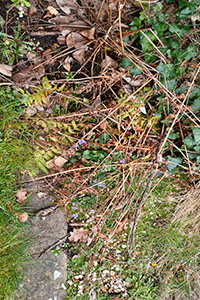
At this time of year, there are several plants coming out of their winter dormancy, such as the fern in photo 2. Cut back any brown leaves down to the base, and you should see any green shoots coming through. You might also notice that there are some everygreen ferns; make sure that you don’t chop these back.

Many perennials need pruning after flowering, and one example is the camellia in photo 3. Camellias will be ready to prune perhaps by mid/end April. You can still prune your roses, which will come back stronger after a good prune.
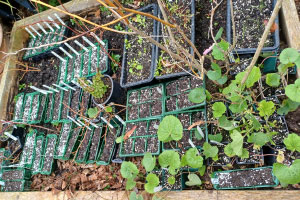
Spring is also the time for seed planting. April temperatures are now probably warm enough (except in the north of the UK), for seeds to be planted out. I often find I have a shortage of space in my greenhouse, so photo 4 shows lots of seeds planted in pots, scattered amongst my blueberries (which aren’t yet leafing up). Such seeds include peas, cauliflower, brussel sprouts, spinach, leeks, lettuce, spring onions, radishes, as well as sweet peas.

I also planted up my pre-chitted potatoes in about mid-March, and they are already sprouting, as shown in photo 5. However, it is not too late to plant them out now in April (no need to chit). These can be sown in potato bags, as per photo 6.
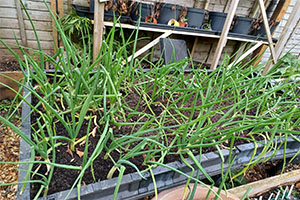
To maximise my space in raised beds, I grow onions, garlic and broad beans over the winter. Photo 7 shows some overwintered onions. These can come out in May/June and – with some added compost and feed – and I then plant my beans and salad crops.

I grow (red) gooseberries, raspberries, blackcurrants and blueberries, as well as the usual apples, pears, plums and rhubarb, and my gooseberry is sometimes attacked by gooseberry sawfly, which you can see in photo 8. So, as an organic gardener, I don’t use any pesticides, so I use nematodes to organically kill gooseberry sawfly, vine weevils, slugs and leatherjackets. Nematodes are microorganisms that burrow into the larva and kill them, perfectly safe for birds and wildlife. They come as a powder (stored until use in the fridge), and then are diluted in water, and applied with a watering can when soil temperature reaches around 12 degrees.
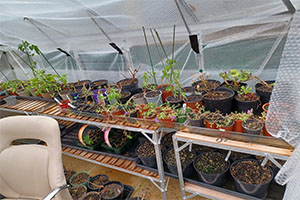
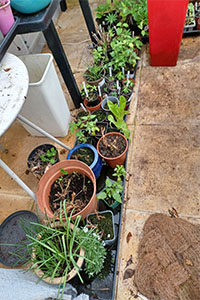
Photos 9 and 10 show a very full unheated but bubble-wrapped greenhouse. This houses overwintered plants like pelargonium and fuchsia, slightly hardier tomato plants and lots more tender seeds.

Spring is the time you need to feed your plants, but it is important that you use the right type of feed. Photo 11 shows a variety of different types of feed (organic if possible), and these can be a bit confusing. Bear in mind the NPK rule. It is the law in the UK/EU, that all feeds must show their percentages of NPK, which are shown on the small print on the back. But what do they stand for?
N stands for Nitrogen, which is used for green growth. Some plants need all nitrogen, like lettuce, cabbage, brussel sprouts and some grasses. All plants need nitrogen in their earliest growth stages, but not later. I obtain mine by making juice from nettles.
P stands for phosphates. You get this from bonemeal, fish/blood/ bone, and wood ash. This is to enhance root growth, so I apply it all around (but not touching) my trees, fruit, shrubs and perennials, usually in the Autumn. You can also apply it to plants with bulbs or corms, such as dahlias, begonias and daffodils.
K stands for Phosphorus, which is used to promote flowers and fruit. Apply it as the first flowers are seen. Tomorite and other tomato feed are examples of this, although I make my own with comfrey.

I also am lucky enough to have a garden room, including some heat mats, where I grow my tomatoes, chillies, cucumbers, aubergines and courgettes. You can see these in photo 12. The chillies were planted in January, the rest in February and March. But don’t worry, April and even May is ok to plant these, and you won’t need a heat mat.

Finally, now is the time to prick out your marigolds, pelargoniums, lobelia, petunias etc into individual pots, as shown in photo 13.
Now I grow an awful lot of plants as you can see, because I have plant fayres over the summer to sell them for charity. But even just a few of your own seeds will brighten up your garden, patio or windowsill, and it really is great fun.
I wish you a happy, healthy and fun Spring 2023.
Previous & Next Articles in this category
Search sources
Similar articles
Tags
Previous & Next Articles in this category
